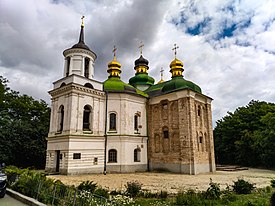Church of the Saviour at Berestove
The Church of the Saviour at Berestovo (Ukrainian: Церква Спаса на Берестові, Tserkva Spasa na Berestovi; Russian: Це́рковь Спа́са на Бе́рестове, Tserkov’ Spasa na Berestove) is a church located immediately north of the Monastery of the Caves in an area known as Berestove. Although it is situated outside the Lavra fortifications, the Saviour Church is part of the Lavra complex and the related World Heritage Site.

Architecture
Berestovo was a suburban residence of Vladimir the Great (who died there in 1015) and some of his descendants, including Vsevolod I and Vladimir II. It was also the site of a monastery, first recorded in 1073. Construction of the present structure is not documented, but most art historians date it to the reign of Vladimir Monomakh (1113–1125). Indeed, it has structural parallels with the churches of Pereyaslav, especially those built during Monomakh's administration of the town at the turn of the 12th century.
Monomakh's court church was larger than most cathedrals built in Kiev in the 12th century and had three naves, three apses, and probably three domes. The western (narthex) wall survives almost intact, while the other walls are known by way of excavations. The western part of the church was separated from the naos, forming a narthex, flanked by a baptistery on the north and a projecting tower on the south. The tower contained the winding stairs leading to the gallery for the ruling prince, his family, and guests.
.jpg)
Art historians believe that the Saviour Church introduced some structural innovations into architecture of Kievan Rus. For the first time in Rus, all three entrances had projecting porches with steeply-pitched trefoil roofs. This novel feature may be interpreted as key to the overall concept of the church. Monomakh's architects apparently wished to emphasize verticality of the church, a basically Gothic formula which would be fully developed in Smolensk and Polotsk.
If the Berestovo church was indeed the first germ of this new manner, its vaulting may have been unusually complicated, probably echoing the trefoil roofing of the porches. The outside of the church formerly displayed intricate brick patterns: double and treble niches, the meander, and decorative crosses. For the first time in Kiev, no limestone was used in the construction, once again foreshadowing the practices of the mid-12th century.
History
Following Monomakh's death, the church was long associated with his family. At least three Monomachids were buried underneath the baptistery: George I of Kiev (the founder of Moscow), his son Gleb and his daughter Eufemia. The church was damaged in 1240 when Batu Khan sacked Kiev and again in 1482, when Khan Meñli I Giray ravaged the neighbourhood. Its walls collapsed and it stood in ruins until the 17th century.
.jpg)
It was the Metropolitan Petro Mohyla who started to restore the Kievan churches, long neglected during the Polish-Lithuanian rule. He had the Berestovo church restored in the national Ukrainian ("proto-Baroque") style. The new church was under construction in 1640-1642. Incorporating the western wall of Monomakh's structure, Mohyla's church is smaller and differs considerably from its predecessor: there are five towers arranged on a four-petaled plan and surrounded by five massive pear-shaped domes. Two years later, a team of Greek masters painted the interior with frescoes. The most famous of these, known as Petro Mohyla's Gift, features a portrait of Mohyla kneeling before Christ to whom he presents a model of the church.
The interior was renovated in 1751–1752 and again in 1813–1814, when Fedor M. Korobka carved an elaborate altar. At the same time, a two-tier belltower was constructed to Andriy Melenskyi's provincial Neoclassical design which is out of keeping with the rest of the church.
In 1909, Academician Pokryshkin (who specialized in ancient Orthodox architecture) was called upon to restore the church to its medieval appearance. Pokryshkin's restoration works lasted for five years but did not result in any fundamental changes. The foundations of Monomakh's original church were uncovered and may still be seen to the east from the extant structure. The façade of the church was cleaned so as to highlight the surviving parts of the 12th-century building, which had been scraped of stucco.
On 7 September 1947, in the course of the celebration of the 800th anniversary of the foundation of Moscow, in the former Vladimir chapel of the church, a large granite sarcophagus was installed by architect P.Ostapenko over the place where it is believed Yuri Dolgoruky, the founder of Moscow, had been buried.
In the early 1970s, a fragment of the 12th-century fresco Miraculous Fishing, depicting Christ walking on water towards a boat, was uncovered in the church. Since Ukraine's independence after the fall of the Soviet Union, the church is part of the Kiev Pechersk Lavra Historical-Cultural Preserve and functions primarily as a museum, holding weekly church services on Sundays.
| Wikimedia Commons has media related to Church of the Saviour at Berestove. |
References
- Pyotr Rappoport. Zodchestavo Drevnei Rusi. Leningrad: Nauka, 1986. (online)
- Malikenaite, Ruta (2003). Touring Kyiv. Baltia Druk. ISBN 966-96041-3-3.
- "Transfiguration Church in Berestove". Encyclopedia of Ukraine. Retrieved November 24, 2006.
- Klymenko, Sergiy. Церква Спаса на Берестові. Pictures of Kyiv (in Ukrainian and Russian). Archived from the original on November 19, 2006. Retrieved November 10, 2006.
- Памятники градостроительства и архитектуры Украинской ССР, 4 volumes, Kiev: Будивэльнык, 1983–86, the article on the Saviour Church in Berestovo (online)